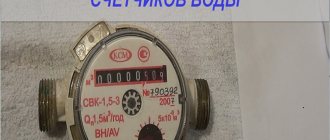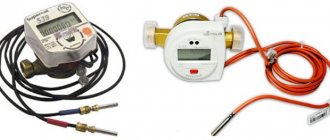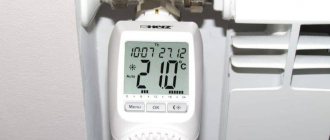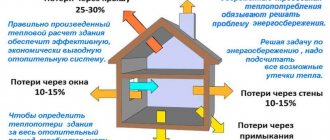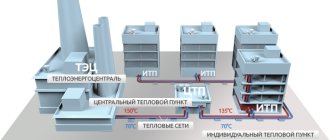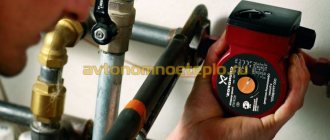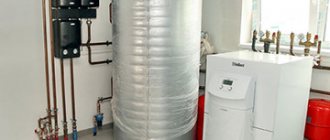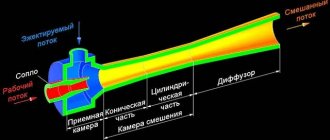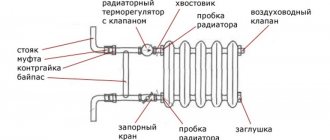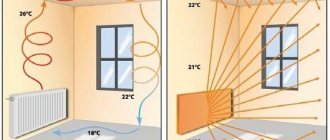All buildings, regardless of whether it is a private house or a high-rise building, are equipped with several life support systems. One of such systems is the heating system and, accordingly, the thermal energy metering unit (UUTE), which is located in the basement of multi-story buildings. What is UUTE, for what purposes is it needed, how does it work and who maintains it?
What devices does the energy metering unit consist of?
Based on the heat consumption characteristics of a particular facility, the number of metering units can be more or less. All nodes are connected using cable routes that lead from the devices to the computer. The calculator, as a rule, is located in the instrument cabinet; it is used to calculate the amount of thermal energy consumed when recalculating instrument readings.
It is also sometimes equipped with a GPRS transmitter, which, using a cellular network, transmits, upon request (or on a schedule), the readings of all connected devices to the water supplier, and, if the necessary settings are available to the transmitters, to the consumer. As a rule, these readings are verified once a day. This type of data transfer is called dispatching. The consumer can also check the readings at any time by simply opening the cabinet and viewing the data displayed on the electronic display of the computer.
Thermal energy metering unit is not one device, but a complex of devices. Installation of uute is necessary for metering and regulating energy and adjusting the amount of coolant inside. Systems serve to register and control parameters. Installation of this equipment is done in the basement of high-rise buildings on heating pipes.
Main parts of equipment:
- Shut-off valves.
- Sensors for monitoring pressure and temperature in the system.
- Shut-off valves.
- Flow, temperature and pressure transducers.
- Calculator.
The heating unit, the installation of which is initially designed for implementation in the communal systems of apartment buildings, is created using a whole complex of various devices and equipment. Such a device can serve one or several functions, which are:
- Measuring the amount of thermal energy, its pressure, mass, volume and temperature of the liquid that passes through the pipeline during operation.
- Collection and archiving of data on local media.
- Displaying information on metering devices.
Based on the data provided, the functioning of heating equipment in apartment buildings is checked, adjusted and serviced.
A metering device is a device such as a meter, the circuit of which includes:
- Primary flow transducer.
- Heat calculator.
- Resistance thermal converter.
Based on the type of primary transducer used (electromagnetic, tachometer, ultrasonic or vortex measurement option), the heat meter can include filters and pressure sensors in its device.
Possible problems
The heating system of a house is a complex mechanism. Some breakdowns and malfunctions are inevitable. But most often problems arise in the heating unit, namely, elevator failures. Reasons of a mechanical nature: defects in shut-off equipment, clogged filters. Because of this, a temperature difference occurs in the pipes before and after passing through the elevator. If the difference is not big, then the problem is not serious: you just need to clean the elevator. Otherwise, repairs are necessary.
Other problems with the heating unit include an increase in the permissible temperature of the measuring equipment and the occurrence of leaks in pipes. When the filters in the pipes become clogged, the pressure increases.
Important! In case of any problem, it is necessary to diagnose the entire heating system.
As already mentioned in the article, elevator units are an obsolete technology. Gradually, in apartment buildings they are being replaced by automatic heating units, which do not require constant human control and regulate all indicators themselves.
The disadvantage of such heating systems is their high cost and, like any automated device, it runs on electricity.
However, devices are built into the circuit of single-circuit units that make it possible to regulate the temperature and pressure in the incoming coolant. Thus, it allows people to save money when paying for utilities.
Why is an accounting system necessary?
Installation of a thermal energy metering unit is carried out at the entrance of pipes into an apartment building in order to perform the following functions:
- checking and adjusting the use of coolant and heat energy;
- adjustment and testing of heating and hydraulic systems;
- reading and archiving coolant data (volume, pressure, temperature)
- carrying out monetary settlements between the consumer and the heat energy supplier, after checking the received data.
Its main goal is to change the characteristics of the internal coolant and monitor energy consumption. What does this mean? Before the coolant enters the consumer’s convector or radiator, the heating unit reduces its pressure and temperature.
If you observe, you will notice that it is impossible to get burned on the radiators and pipes of the heating system. This point is useful not only for consumers, but also directly for the heating system itself. Now the metal pipeline is being replaced with polypropylene or metal-plastic. But such pipes do not tolerate high pressure and temperature quite well.
Here are several regulated operating modes of the heat metering unit:
- 110/70;
- 130/70;
- 150/17.
These parameters indicate what maximum and minimum temperatures of the coolant in the pipes are allowed. A thermal energy meter is installed on each metering unit.
Effective use of an automated heating control unit
An example of a diagram of a control unit for heating systems and heat supply installations.
Related article: Sanding parquet boards with your own hands (video and photos)
The use of the unit will be most effective in cases where the house has subscribed elevator units of heating systems that are directly connected to the city heat main networks. Such use will also be effective in the conditions of end houses connected to central heating stations, where there are insufficient pressure drops in the central heating system with the obligatory installation of central heating pumps.
The efficiency of use is also noted in houses that are equipped with gas water heaters and central heating; such buildings may also have a decentralized hot water supply.
It is recommended to install automated units comprehensively, covering all non-residential and residential buildings that were connected to the central heating point. Installation and delivery, as well as subsequent acceptance into operation of the entire system and associated equipment of the unit must be carried out simultaneously.
It should be noted that with the installation of an automated unit, the following measures will be effective:
- Converting the central heating station, which has a dependent connection scheme for individual heating systems, to one that will be independent. In this case, installing an expansion membrane tank at a heating point will also be effective.
- Installation in a central heating substation, which is characterized by a dependent circuit for connecting equipment similar to an automated control unit.
- Carrying out the adjustment of intra-block central heating networks with the installation of throttle diaphragms and design nozzles at the input and distribution nodes.
- Converting dead-end hot water systems to circulation circuits.
The operation of exemplary automated units has shown that the use of automatic control units in conjunction with balancing valves, thermostatic valves and the implementation of insulation measures can save up to 37% of thermal energy, providing comfortable living conditions in each of the premises.
The best posts
- Floor joists: the size of the timber and the distance between the joists, table and how to strengthen the floors, arrangement in the house
- Bamboo roller blinds in window design: how to choose and what to pay attention to
- DIY single bed: assembly, tools, materials
- DIY installation of MDF panels (photo)
- Where are radius doors used: types and materials
- DIY everything for the home: master classes with photos and videos
- Faucet with hygienic shower
- Photo collage on the wall: how to create it yourself
How to install a heating unit correctly?
Installing a circuit for heat metering equipment in an apartment building implies compliance with the following fundamental requirements during its installation:
- installation of the thermal energy metering equipment circuit must be done only at the boundaries of the balance section of the pipeline in places that are closest to the main valves of the heat source;
- prohibition of taking coolant from the municipal heating system for personal needs;
- adjustment of the average daily and average hourly characteristics of the coolant is done based on the readings of metering devices;
- metering devices must be installed on the return main pipelines and located before the point of connection of the make-up pipeline.
The thermal energy meter must be mounted at the input of heating networks into the ITP room. Before and after the location of the flow meters (at the supply and return) of the metering unit, two control flow meters (or at least fittings for pressure gauges) must be installed. After the inlet pressure gauge, it is necessary to place a special device - a flow meter. Its task is to take into account the volume of coolant passing through a given pipe.
A temperature sensor is installed after the flow meter. As a rule, such a device is not equipped with a special control panel or an arrow that would indicate the temperature, so another control thermometer is installed next to it, which allows you to check the temperature visually.
The location of the heating unit in an apartment building is in the basement, from where heat is supplied to the apartments. In this case, it is connected according to the elevator circuit. It is quite simple and cheap. The main disadvantage of such a system is that it is impossible to make adjustments in the pipes. Because of which some end users may experience some inconvenience. During thaws during the heating season, heat energy is overused.
The main element of this scheme is the elevator. In order to reduce the pressure, a reducer can be installed in front of it. The elevator itself is necessary for mixing the cooled coolant with the hot one. The basis of its operation is the vacuum created at the output. Thanks to it, the coolant in the elevator is under lower pressure, which is why mixing occurs.
But there is another scheme for installing the system. Its operating principle is based on a heat exchanger. Due to the fact that the heating point is connected through this heat exchanger, the coolant in the house and in the heating main is separated. Thanks to this, it becomes possible to carry out its preparation. For this purpose, filtration and additives are used.
Thanks to this scheme, it becomes possible to regulate the temperature and pressure of the coolant in the pipes. Why is this so important? This scheme makes it possible to reduce heating costs.
If we consider the addition of coolant, this sample shows that it is carried out using thermostatic valves. One of the positive aspects is the possibility of using thermostatic valves, and the ability for consumers to use aluminum batteries. But there is a small nuisance - if low-quality coolant is used, the battery life is reduced. Naturally, there is no such possibility as quality control of the coolant.
Important! After connecting the DHW through the heat exchanger, you can control the pressure and temperature of the coolant.
Thermal unit in an apartment building: principle of operation 2021
One of the key parts of the heating main is the thermal unit. The diagram of the heating unit, the structure and the principle of operation may seem somewhat incomprehensible to a beginner, but with minimal knowledge, you can fully understand these intricacies, which will help in the future to equip a highly efficient heating main. First of all, you should consider the basic points.
The heating point is located at the entrance of the heating main to the premises. Its main task is to change the operating parameters of the coolant fluid, and to be precise, to reduce the temperature and pressure of water before it enters the radiator or convector. This process is necessary not only to increase the safety of residents and prevent possible burning upon contact with the battery, but also to increase the service life of all equipment. The function is indispensable in cases where the building has polypropylene or metal-plastic pipes.
The relevant documentation indicates the regulated operating modes of such units. They indicate the upper and lower temperature thresholds to which the coolant can warm up. Also, according to modern standards, each unit must have a heat sensor that determines the current indicators of the liquid with which the heating unit operates.
The design, principle of operation and design of thermal equipment may depend on several features, including the design, which was created taking into account the individual requirements of customers. Among the existing types of thermal units, elevator-based models are in particular demand . This scheme is characterized by particular simplicity and accessibility, but with its help it is impossible to change the temperature of the liquid in the pipes, which causes a lot of inconvenience to the consumer. The main problem is the excessive consumption of thermal resources during temporary thaws during heating.
In a system of thermal units based on an elevator, there may be a reduced pressure reducer, which is located directly in front of the elevator. The elevator itself mixes the cooled liquid from the return pipe to the heated coolant that has reached the supply circuit.
The operating principle of the unit is based on creating a vacuum at the outlet, which significantly reduces the water pressure and starts the mixing process.
The design of a thermal unit involves a lot of components that are interdependent and function for one common purpose.
Among the main elements of the system:
- 1. Shut-off valves.
- 2. Heat meter.
- 3. Mud trap.
- 4. Coolant flow sensor.
- 5. Thermal sensor of the return pipeline.
- 6. Additional equipment.
Depending on the individual characteristics of the object, the system can be equipped with additional sensors and other components. As for installation, it must be carried out taking into account certain rules and requirements :
- 1. The installation of the scheme should take place directly at the boundaries of the balance sheet section.
- 2. Using coolant from a common communal system for individual needs is strictly prohibited.
- 3. To monitor average hourly and average daily indicators, it is necessary to take into account the operating properties of accounting equipment.
- 4. Any sensors and metering devices are fixed on the return pipeline.
There is another type of heating unit for a private house - based on a heat exchanger. In this case, a special heat exchanger is attached to the device, which separates the liquid from the heating main from the liquid in the room. This function is necessary for additional preparation of the coolant using various additives and filtering devices. The scheme expands the possibilities for regulating the pressure and temperature of the coolant inside the building. Thus, heating costs for the building are significantly reduced.
Thermostatic valves must be used to mix water at different temperatures. Such systems interact normally with aluminum radiators, but in order for the latter to last as long as possible, it is necessary to carefully select the coolant, abandoning low-quality raw materials. Of course, keeping track of the quality of the liquid is problematic, so it is better to abandon this material, giving preference to bimetallic or cast iron radiators.
The DHW connection diagram involves the use of a heat exchanger. This method provides many advantages, including :
- 1. Possibility of adjusting water temperature.
- 2. Possibility of changing the pressure of the hot coolant.
Unfortunately, many management companies do not monitor the coolant temperature, and sometimes even lower it by several degrees. The average consumer will hardly notice such changes, but on the scale of an entire home, this means saving impressive amounts of money.
In multi-apartment and multi-storey premises, administrative buildings and other objects with a large area, highly efficient thermal power plants or powerful boiler houses are used. In private cottages and small houses, simple autonomous systems are used that operate on an understandable principle.
However, even with such installations, certain problems arise that make it difficult to adjust or change operating parameters. And in large boiler houses or thermal power plants, the circuits of such equipment are much more complex and larger. A mass of branches diverge from the central pipe to each consumer. Moreover, in each of them there is a different pressure, and the volumes of heat consumed differ significantly. The length of the pipeline varies, so the system must be designed correctly so that the most distant point receives the required amount of thermal energy.
The coolant pressure difference is necessary for the normal movement of the coolant along the circuit, i.e. it is a natural alternative for pumping equipment. At the system design stage, it is necessary to adhere to the established scheme, otherwise the risk of imbalance will increase when the volume of heat consumed changes.
Moreover, strong branching of equipment should not interfere with the efficiency of heat supply. To ensure stable operation of the DSP (centralized heating system), it is necessary to equip each room with a personal elevator unit or a special automated control unit.
The designs are particularly convenient for all apartment buildings. And if someone thinks that it is possible not to use such a unit, replacing it with a natural supply of water with a slightly lower temperature, then this is a deep misconception, because in the absence of an elevator unit, it will be necessary to increase the diameter of the lines to supply a less hot coolant. If such a part is available, it will be possible to add a certain amount of coolant to the supply liquid from the return circuit, which has already cooled down sufficiently.
However, there is an opinion that the use of an elevator unit is an old method, because there are already more progressive solutions on the market, namely :
- 1. mixer with 3-way valve;
- 2. plate heat exchanger.
Unfortunately, even such a simple device as an elevator unit is subject to various failures and malfunctions. To determine the malfunction, it is necessary to analyze the readings of pressure gauges at control points.
One of the key reasons for damage to the elevator unit is a large accumulation of debris in the pipelines. Often this debris is dirt and solids in the water. If there is a sharp decrease in pressure in the heating system, a little further than the sump tank, it is necessary to clean this tank. Dirt is discharged using drainage channels, after which the grids and internal surfaces of the structure are serviced.
In the event of pressure surges, it is necessary to check the system for the presence of corrosion processes or debris. The problem may also be caused by the nozzle collapsing, causing the pressure level to become too high.
Even in the operation of elevator units, phenomena occur in which the pressure begins to increase at an incredible rate, and the pressure gauges before and after the mud tank display the same value. If this is the case, it is necessary to carry out a comprehensive cleaning of the return circuit sump. To do this, open the taps, clean the mesh and get rid of all the dirt inside.
If the nozzle dimensions have changed due to corrosion processes, a vertical misalignment of the heating circuit may have occurred. In this case, the lower radiators will warm up quite well, and the upper ones will remain cold. To eliminate the problem, you need to replace the nozzle.
Experienced engineers and heating engineers recommend using one of three operating modes of the boiler installation. Such recommendations were created taking into account theoretical data and mathematical calculations, and were also confirmed by many years of practical experience. Each of the selected modes guarantees highly efficient heat transfer with low losses. At the same time, even the large length of the highway does not affect the efficiency indicators.
This is interesting: Storage room on the landing: how to legalize it? 2021
These modes differ from each other in the different temperature ratios on the supply and return circuits:
- 1. 150/70 degrees Celsius.
- 2. 130/70 degrees Celsius.
- 3. 95/70 degrees Celsius.
When choosing the optimal ratio, it is important to take into account several factors, including regional characteristics and the average winter air temperature. If we are talking about heating a private house, it is better to refuse to use the first two modes, which involve heating the coolant to 150 and 130 degrees Celsius. At such temperatures, there is a risk of dangerous burns and other consequences from depressurization.
As is known, the liquid in the pipeline is heated to temperatures that exceed the boiling point. However, it never boils, which is due to the corresponding pressure. If it is necessary to select the optimal mode for a private building, you need to reduce the pressure and temperature, for which an elevator unit is used. The element itself is a special heating equipment, which is located at the distribution point.
Having understood the heating unit diagram, you can proceed directly to installation work. As you know, such installations are often used in multi-apartment premises that are connected to a common communal heating system.
Thermal units are designed for such tasks:
- 1. Checking and changing the operating properties of the coolant and thermal potential.
- 2. Monitoring the current state of heating systems.
- 3. Monitoring and recording the main indicators of the coolant - current temperature, pressure and volume.
- 4. Carrying out monetary calculations and drawing up an optimal energy expenditure plan.
When installing a heating system in a room, you need to understand that central heating requires certain costs. If we are talking about an apartment building, then all costs are divided among the residents. But sometimes they are unjustified due to the dishonest attitude of management companies and incorrect installation of system parts.
And in order to prevent significant financial damage, it is important to install in advance a highly efficient heating unit in a private home, which will automatically regulate any changes and select the optimal coolant temperature ratio. Only competent testing of equipment and proper maintenance will allow you to set up an effective heating system that will last for many years without failures.
In any building, including a private house, there are several life support systems. One of them is the heating system. In private houses, different systems can be used, which are selected depending on the size of the building, the number of floors, climate conditions and other factors. In this material we will analyze in detail what a thermal heating unit is, how it works and where it is used. If you already have an elevator unit, then it will be useful for you to learn about the defects and how to eliminate them.
This is what a modern elevator unit looks like. The unit shown here is electrically driven. There are also other types of this product.
In simple words, a heating unit is a complex of elements that serve to connect the heating network and heat consumers. Surely readers have a question whether it is possible to install this unit yourself. Yes, you can if you know how to read diagrams. We will look at them, and one scheme will be analyzed in detail.
To understand how the node works, it is necessary to give an example. To do this, we will take a three-story house, since the elevator unit is used specifically in multi-story buildings. The main part of the equipment that belongs to this system is located in the basement. The diagram below will help us better understand the work. We see two pipelines:
- The server.
- Back.
Diagram of a heating unit for a multi-storey building.
Now you need to find on the diagram the thermal chamber through which water is sent to the basement. You can also notice shut-off valves, which must be installed at the entrance. The choice of fittings depends on the type of system. For the standard design, valves are used. But if we are talking about a complex system in a multi-story building, then the experts recommend using steel ball valves.
When connecting a thermal elevator unit, you must adhere to the standards. First of all, this concerns temperature conditions in boiler rooms. During operation, the following indicators are allowed:
- 150/70°C;
- 130/70°C;
- 95(90)/70°C.
When the liquid temperature is in the range of 70-95°C, it begins to be evenly distributed throughout the system due to the operation of the collector. If the temperature exceeds 95°C, the elevator unit begins to work to lower it, since hot water can damage equipment in the house, as well as shut-off valves. This is why this type of construction is used in multi-storey buildings - it controls the temperature automatically.
As you understand, the unit consists of filters, an elevator, instrumentation and fittings. If you plan to install this system yourself, then it’s worth understanding the diagram. A suitable example would be a high-rise building, in the basement of which there is always an elevator unit.
In the diagram, the system elements are marked with numbers:
1, 2 – these numbers indicate the supply and return pipelines that are installed in the heating plant.
3.4 – supply and return pipelines installed in the heating system of the building (in our case, this is a multi-storey building).
6 – this number indicates coarse filters, which are also known as mud filters.
The standard composition of this heating system includes control devices, mud traps, elevators and valves. Depending on the design and purpose, additional elements may be added to the unit.
It is worth saying that utilities become more expensive every year, and this also applies to private homes. In this regard, system manufacturers provide them with devices aimed at saving energy. For example, now the circuit may contain flow and pressure regulators, circulation pumps, pipe protection and water purification elements, as well as automation aimed at maintaining a comfortable mode.
Another variant of the thermal elevator unit diagram for a multi-storey building.
Also in modern systems a thermal energy metering unit can be installed. From the name you can understand that it is responsible for accounting for heat consumption in the house. If this device is missing, the savings will not be visible. Most owners of private houses and apartments strive to install meters for electricity and water, because they have to pay significantly less.
From the diagrams you can understand that the elevator in the system is needed to cool the overheated coolant. Some designs have an elevator, which can also heat water. This heating system is especially relevant in cold regions. The elevator in this system starts only when the cooled liquid is mixed with hot water coming from the supply pipe.
Scheme. The number “1” indicates the supply line of the heating network. 2 is the return line of the network. The number “3” indicates the elevator, 4—the flow regulator, and 5—the local heating system.
From this diagram you can understand that the unit significantly increases the efficiency of the entire heating system in the house. It works simultaneously as a circulation pump and mixer. As for the cost, the unit will be quite cheap, especially the option that operates without electricity.
But any system also has disadvantages, the collector unit is no exception:
- Separate calculations are required for each element of the elevator.
- Compression drops should not exceed 0.8-2 bar.
- Lack of ability to control high temperature.
Recently, elevators have appeared in the public utilities sector. Why did you choose this particular equipment? The answer is simple: elevators remain stable even when changes in hydraulic and thermal conditions occur in the networks. The elevator consists of several parts - a vacuum chamber, a jet device and a nozzle. You can also hear about “elevator piping” - we are talking about shut-off valves, as well as measuring instruments that allow you to maintain the normal operation of the entire system.
This is interesting: Replacement of elevators under the overhaul program in an apartment building in 2021
As mentioned above, elevators equipped with electric drives are used today. Due to the electric drive, the mechanism automatically controls the diameter of the nozzle, as a result, the temperature is maintained in the system. The use of such elevators helps reduce energy bills.
The image shows all the elements of the elevator.
The design is equipped with a mechanism that rotates due to an electric drive. Older versions use a toothed roller. The mechanism is designed so that the throttle needle can be moved in the longitudinal direction. In this way, the diameter of the nozzle changes, after which the coolant flow can be changed. Due to this mechanism, the consumption of network fluid can be reduced to a minimum or increased by 10-20%.
A common malfunction is mechanical failure of the elevator. This may occur due to an increase in the diameter of the nozzle, defects in shut-off valves, or clogged mud traps. It is quite simple to understand that the elevator is out of order - there are noticeable differences in the temperature of the coolant after and before passing through the elevator. If the temperature is low, the device is simply clogged. When there are large differences, elevator repair is required. In any case, when a malfunction occurs, diagnostics are required.
The elevator nozzle gets clogged quite often, especially in places where the water contains many additives. This element can be dismantled and cleaned. If the nozzle diameter has increased, adjustment or complete replacement of this element is necessary.
The photo shows the process of servicing the elevator heating system.
Other malfunctions include overheating of devices, leaks and other defects inherent in pipelines. As for the mud tank, the degree of its clogging can be determined by the readings of the pressure gauges. If the pressure increases after the mud filter, then the element needs to be checked. » alt=»»>
Central heat supply lines for apartment buildings are complex complexes. They transfer heat through pipelines from the supplier to the end consumer. Hot coolant is supplied through a distribution manifold and gradually fills the radiators inside the house. To equalize the temperature, a special device is used - an elevator unit.
Before understanding the diagram of the elevator heating unit, it must be said that by its design the elevator is a kind of circulation pump, which is located in the heating system along with pressure meters and shut-off valves.
Thermal elevator units perform a number of functions in their operation. To begin with, this electronic device distributes pressure in the heating system so that water is delivered to consumers into the heating radiators at a certain pressure and temperature. During circulation through pipes from the boiler room to multi-storey buildings, the volume of coolant in the circuit almost doubles. This can only happen if there is a supply of water in a separate sealed container.
From this video we will learn the principle of operation of the elevator heating unit:
It is also noteworthy that SNiP currently indicates the coolant temperature standard in the range of 65℃. But to save resources, there is active discussion about reducing this standard to 55℃. Taking into account the opinion of experts, the consumer will not feel a significant difference, and for disinfection, the thermal fluid will need to be heated to 75℃ once a day. However, these changes to SNiP have not yet been adopted, since there is no precise opinion regarding the effectiveness and appropriateness of this decision.
The diagram of the elevator unit of the heating system makes it possible to bring the temperature regime of the coolant to regulatory requirements.
This device allows you to prevent the following consequences:
- if the wiring is made of propylene or plastic pipes, then it is not designed to supply hot thermal fluid;
- not all heating pipes are designed for prolonged exposure to elevated temperatures under high pressure - these conditions will lead to their rapid failure;
- Very hot heating radiators can cause burns if not handled carefully.
Many consumers say that the heating elevator design is irrational, and it is much easier to supply users with coolant at a lower temperature. In fact, this approach involves increasing the diameter of the central heating pipeline to circulate cooler coolant, which implies additional costs.
That is, a high-quality heating unit design allows you to use part of the cooled water from the return flow with the supply volume of coolant. Despite the fact that some elevator sources are outdated hydraulic devices, in fact, they are the most efficient in operation . There are also more modern devices that have replaced elevator unit systems.
This includes the following types of devices:
- mixer equipped with a three-way membrane;
- plate heat exchanger.
Considering the diagram of a heating elevator, one cannot help but note the similarity of the finished equipment with water pumps. Moreover, for operation there is no need to obtain energy from other systems.
In appearance, the main part of the device resembles a hydraulic tee, which is installed on the return circuit of the heating system. Through a regular tee, the coolant would easily flow into the return, bypassing the batteries. This thermal unit diagram would be inappropriate.
The standard heating elevator circuit contains the following elements :
- A preliminary chamber and a coolant supply pipe with a nozzle of a certain diameter installed at the end. Water from the return circuit circulates through it.
- A diffuser is installed at the outlet, which is designed to supply coolant to users.
Today you can find units in which the size of the nozzle is adjusted by an electric drive. Due to this, you can automatically adjust the required temperature of the circulating water.
The choice of a heating unit circuit with an electric drive is made taking into account the possibility of changing the mixing coefficient of the coolant in the range of 3-6 units. This cannot be done in elevators where the nozzle cross-section does not change. Thus, units with an adjustable nozzle can significantly reduce heating costs, which is important for multi-storey buildings with central meters.
If the heating system uses a heating unit diagram for an apartment building, then its high-quality operation can be organized only on the condition that the operating pressure between the return and supply circuits is higher than the calculated hydraulic resistance.
The operating diagram of the elevator in the thermal unit is as follows::
- hot coolant is supplied through a central pipeline to the nozzle;
- circulating through small-diameter pipes, the coolant begins to increase speed;
- and a discharged zone appears;
- the resulting vacuum “sucks” water from the return circuit;
- turbulent water flows through the diffuser to the outlet.
Despite the fact that the elevator unit has many advantages, it also has one significant drawback. It’s just that the elevator circuit does not provide for the possibility of adjusting the temperature of the outgoing coolant.
If the return water temperature indicates that it is very hot, you will need to reduce it. This problem can only be solved by reducing the size of the nozzle, but this cannot always be done due to the design features of the equipment.
In some cases, the heating unit is equipped with an electric drive, thanks to which the size of the nozzle can be adjusted. It moves the main structural element - the throttle cone needle. This needle moves a certain distance into the hole inside the nozzle. The depth of movement makes it possible to change the diameter of the nozzle and thereby regulate the temperature of the coolant.
This is interesting: Thermal energy for hot water supply in the receipt - what is it? 2021
Both a manual drive in the form of a handle and a remotely controlled electric motor can be installed on the shaft.
It must be said that the installation of this temperature regulator makes it possible to improve the overall heating system with a thermal unit without significant material costs.
Despite the reliability of the equipment, in some cases the elevator heating unit may malfunction. Hot coolant and increased pressure quickly find vulnerable areas and provoke failure of this device. This inevitably happens if individual elements are poorly assembled, the nozzle size is calculated incorrectly, or due to blockages.
Noise in the heating pipe . The elevator heating unit may create noise during operation. If this is noted, it means that unevenness or cracks have appeared at the nozzle outlet during operation.
The reason for the formation of these defects is the distortion of the nozzle, which is caused by the supply of hot water under high pressure. This can happen if excessive pressure is not throttled by the flow regulator.
The quality operation of the heating elevator can be questioned if the temperature on the input and output circuits differs significantly from the temperature graph. Most likely, the reason for this is the oversized nozzle.
A faulty throttle can lead to a change in coolant flow in contrast to the design indicator.
This violation can be easily determined by changing the temperature in the supply and return pipes. The problem can be solved by repairing the flow regulator.
If the connection diagram of the heating system to the external main is independent, then the cause of poor elevator operation can be caused by faulty water heating elements, circulation pumps, protective and shut-off valves, various leaks in equipment and pipes, and failure of regulators.
The main reasons that negatively affect the principle of operation and design of pumping equipment include the destruction of elastic membranes in the joints of the shafts of the electric motor and the pump, wear of bearings and failure of the seats under them, the appearance of cracks and irregularities in the housing, and leakage of seals. All of the above breakdowns can only be eliminated through repairs .
Poor operation of water heaters can be observed if the tightness of the pipeline is broken, sticking or destruction of the pipe assembly occurs. The problem can only be solved by replacing the pipes.
Blockages are one of the most common causes of poor-quality heat supply. Their appearance is caused by dirt getting into the heating system if the dirt filters do not cope with their task. Corrosion build-ups inside the pipeline can also increase the problem.
The level of filter contamination can be determined by the pressure gauges that are installed near the filter and behind it. A strong pressure drop can confirm or refute the assumption about the level of contamination. To clean the filters, it is necessary to remove dirt through the drain valves , which are located at the bottom of the housing.
Any malfunctions in the heating equipment and pipes system must be corrected immediately!
Any comments that do not affect the operation of the heating system must be recorded in special documentation ; it must be included in the plan for capital or routine repairs of equipment. Troubleshooting must be done in the summer before the heating season.
No one will argue that the heating system is one of the most important life support systems of any home, both a private house and an apartment. If we talk about apartments, centralized heating often predominates in them; in private houses, autonomous heating systems are most often found. In any case, the design of the heating system requires close attention. For example, in this article we will talk about such an important element as the elevator heating unit, the purpose of which is not known to everyone. Let's figure it out.
In order to clearly understand the structure and purpose of the elevator unit, you can go into an ordinary basement of a multi-story building. There, among the other elements of the thermal unit, you can find the required part.
Elevator heating unit
Let's consider a schematic diagram of the coolant supply to the heating system of a residential building. Hot water is supplied through pipelines to the house. It is worth noting that there are only two pipelines, of which:
- 1- supply (supplies hot water to the house);
- 2-reverse (removes the coolant that has released heat back to the boiler room);
Water heated to a certain temperature from the thermal chamber enters the basement of the building, where shut-off valves are installed on the pipelines at the entrance to the heating unit. Previously, gate valves were installed everywhere as shut-off valves; now they are gradually being replaced by ball valves made of steel. The further path of the coolant depends on its temperature.
In our country, boiler houses operate according to three main thermal regimes:
If the water in the supply pipeline is heated to no more than 95 0 C, then it is simply distributed throughout the heating system using a manifold equipped with control devices (balancing valves). If the temperature of the coolant is above 95 0 C, then according to current standards such water cannot be supplied to the heating system. You need to cool it down. This is where the elevator unit comes into play. It is worth noting that the elevator heating unit is the cheapest and simplest way to cool the coolant.
With the help of an elevator, the temperature of the superheated water drops to the calculated temperature, after which the prepared coolant is sent to the heating devices. The operating principle of the elevator unit is based on mixing superheated coolant from the supply pipeline with cooled water from the return pipe.
The diagram of the elevator assembly below clearly shows that the elevator performs 2 functions at once, which makes it possible to increase the overall efficiency of the heating system:
- Works as a circulation pump;
- Performs mixing function;
Elevator unit diagram
The advantage of the elevator is its simple design and, despite this, high efficiency. Its cost is low. It does not require an electrical connection to operate.
It is worth mentioning the disadvantages of this element:
- There is no possibility of regulating the outlet water temperature;
- The pressure difference between the supply and return pipelines should not fall outside the range of 0.8-2 Bar;
- Only accurate calculation of every detail of the elevator guarantees its efficient operation;
Today, elevators are still widely used in heating units of residential buildings, since the efficiency of their operation does not depend on changes in thermal and hydraulic conditions in heating networks. In addition, the elevator unit does not require constant supervision, and to adjust it, it is enough to select the correct nozzle diameter. It is worth remembering that the entire selection of elevator unit elements should be trusted only to specialists who have the appropriate permits.
Elevator diagram
In addition, the elevator unit includes the so-called “elevator piping”, consisting of control pressure gauges, thermometers, and shut-off valves. Recently, elevators have appeared equipped with an electric drive to regulate the diameter of the nozzle. Such an elevator allows you to automatically regulate the temperature of the coolant entering the heating system. However, such models are not yet widely used due to the low degree of reliability.
Technologies used in the public utilities sector are constantly evolving. Elevators are being replaced by thermal units with automatic temperature control of the supply and return coolant. They are more economical and compact, but their cost compared to an elevator is quite high. In addition, they require an electrical connection to operate.
»
Other
Removal of bulky waste: rules and features 2021
Read more
Great article 0
Is it possible to install a heat meter in an apartment?
The supply of thermal energy is paid according to the readings of the installed common building meter, which is made as follows: the total amount is divided between apartments in proportion to their area.
Not everyone is happy with this method, because... Some consumers have insulated their walls and installed energy-saving windows, while some continue to live with old wooden ones. Because some people have insulated their homes and invested in minimizing heat loss, it is unfair to charge them the same rate as everyone else.
Because of this, many consumers are interested in the possibility of installing individual metering devices. Their installation does not require OSBB registration and other bureaucratic red tape. The main task in this case is to develop a project, that is, a plan for the location of the equipment, install the device, and coordinate all your actions with the supplier of this service. Unfortunately, such pleasure is not available to most consumers, and here’s why.
Heat metering implies that it comes from a single source, but in most apartments there are several of them due to the vertical distribution. Because of this, it is necessary to install a device on each riser, which is quite expensive and it will be much cheaper to continue paying according to the old scheme.
The option of redoing the vertical wiring is quite complex and unpromising, since it may cause an imbalance in the system. Only apartment owners in new buildings with horizontal wiring can install an individual apartment meter without any problems.
Owners of apartments with a horizontal heating system can install a device that matches the diameter of the pipes supplying coolant to the apartment. If you have a certified project, a certificate for the meter and other documentation, the heat meter can be registered with the management organization and you can pay for services upon delivery.
Not long ago, overhead meters appeared on the market; they read the heat expended by each radiator. They are quite cheap and almost anyone can purchase a device for each radiator. Another issue is that many suppliers will not want to recognize these devices for charging purposes and may refuse to register them.
Who should be responsible for equipment maintenance?
Apartment buildings are connected to a central heating system (HS) and hot water supply (DHW), the supply pipeline of which is located in the basement, equipped with shut-off valves, which allows, if necessary, to disconnect the intra-house heating system from the external network.
The heating unit itself is equipped with shut-off valves, mud traps, control and measuring instruments, and an elevator is included in its design. Of all the devices, the mud collector usually requires the most frequent maintenance; it looks like a steel pipe, whose diameter is DN 159-200 mm; its task is to collect dirt that can be brought from the main pipeline to protect pipelines and heating devices from contamination.
If we are talking about installation or maintenance of heat metering, then all this is done by specially trained people who have undergone special instructions and are allowed to perform this work. This is due to the fact that the premises are a place with increased danger. Not only can you damage equipment that costs several tens of thousands, but you can also get hurt yourself.
Therefore, you don’t need to go inside to make the settings as you like. There is no need to risk your health in vain. In the event that any malfunctions arise, immediately contact the appropriate authorities. Installation of the thermal unit, its service and cleaning are carried out by mechanics who service this area, performing the tasks assigned to them by the organization whose sphere is housing and communal services.
A heat energy metering system is a mandatory attribute of all high-rise buildings. Due to the fact that it is possible to find out the temperature of the coolant inside, the system can be adjusted to its optimal performance. Thanks to this, you can save a lot on heating costs, as well as increase the service life of heating devices. Private houses can also be connected to similar nodes if they are connected to a central heating network. Although the system is quite expensive, thanks to it you can arrange your life as comfortably as possible during the cold period.
